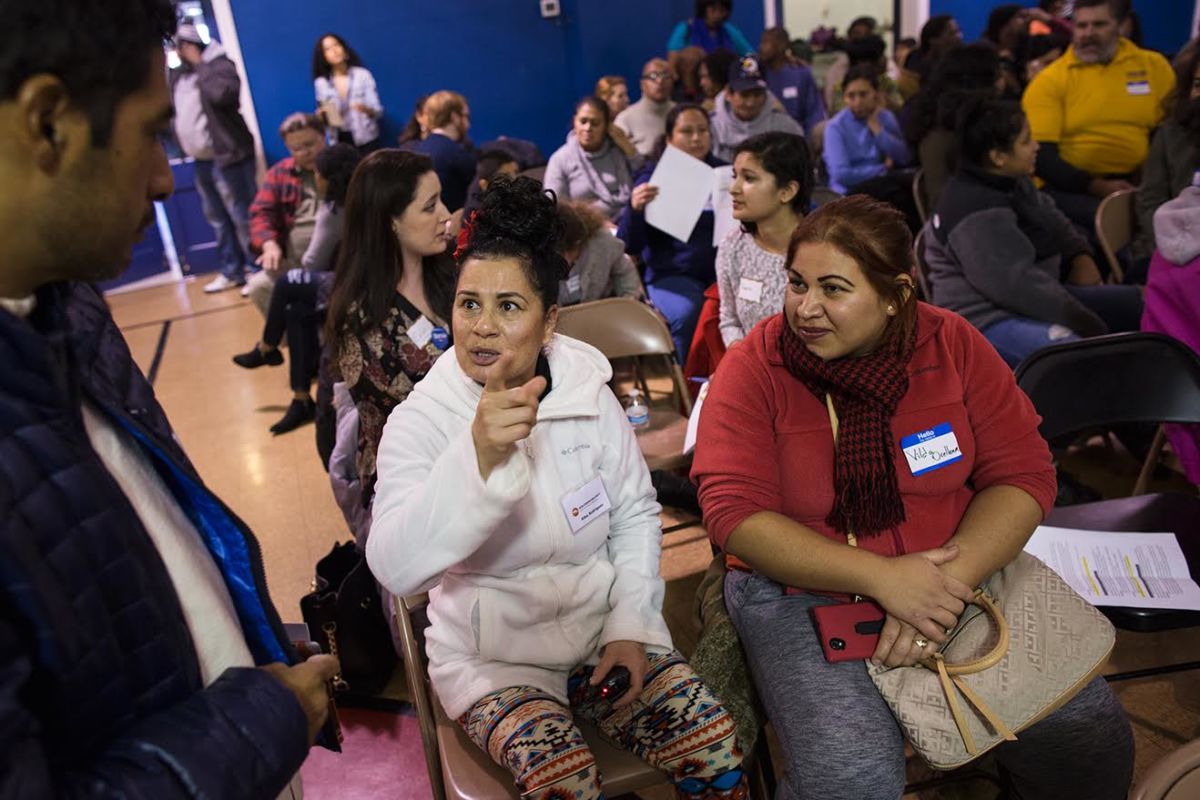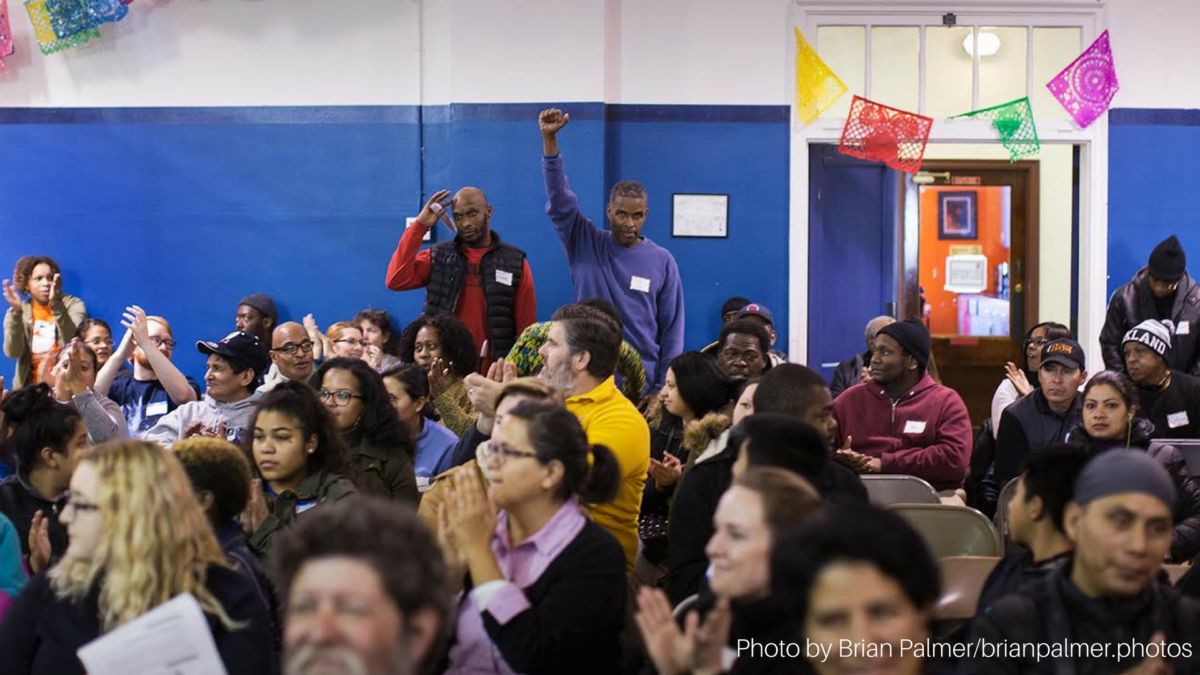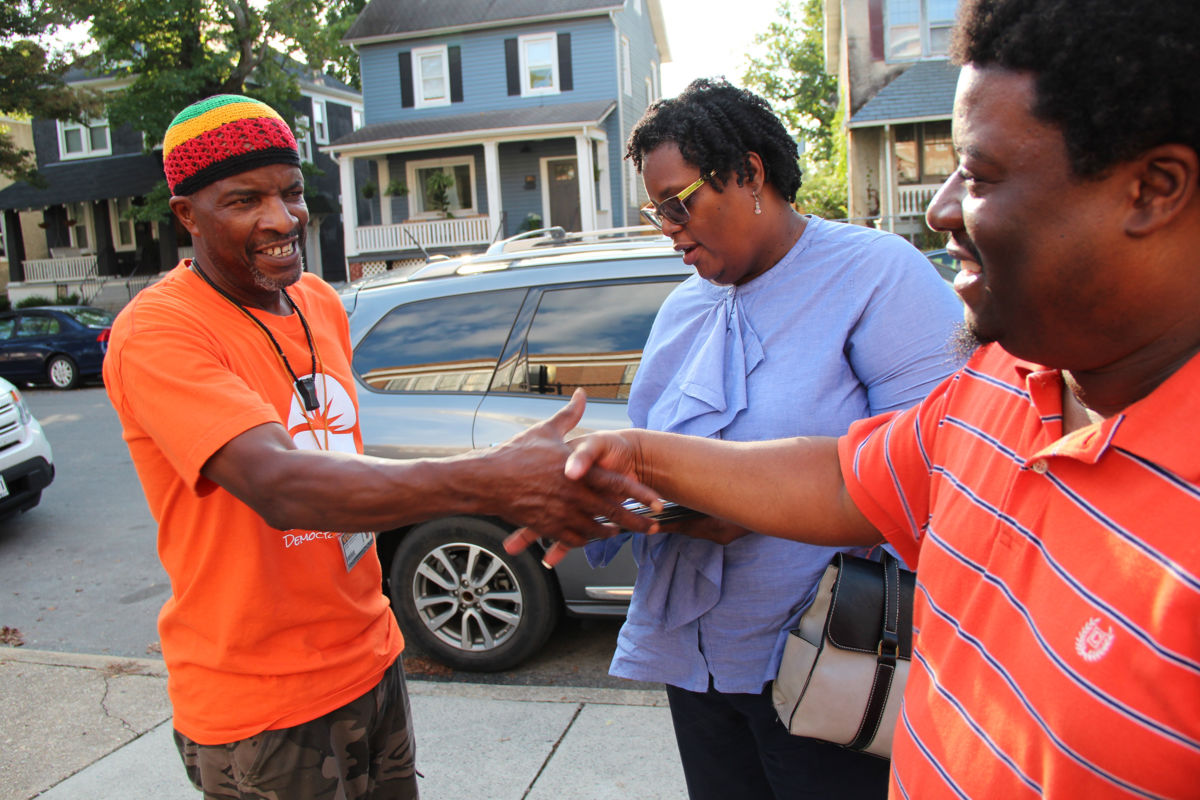Jamaa Bickley-King can’t help but laugh when recalling the partisan proposals to redraw Virginia state legislative districts that were unveiled by state lawmakers over the past two months. A federal judicial panel invalidated the current electoral map earlier this year, ruling that the Republican-controlled legislature had illegally gerrymandered 11 Virginia legislative districts by packing Black voters into solidly Democratic areas. Democrats and Republicans in the Virginia legislature proposed dueling maps to remedy the problem, with each side claiming that their mapmakers did not rely on racial demographics to draw new lines. Republicans even described their proposal as “race-blind.” Bickley-King said that just didn’t make sense.
“If a judge declares that an electoral map has been illegally gerrymandered based on race, you can’t undo the damage by simply taking race out of equation,” said Bickley-King, who directs the New Virginia Majority, a grassroots group building power in working-class communities of color.
The New Virginia Majority decided to draw up its own electoral map and add it to the proposals before the Virginia House of Delegates, which was given until October 30 to decide on a new map before federal judges appoint an outside expert to do the job in time for the 2019 election season. Instead of pretending that partisan politics have nothing to do with race, the activists worked with a data firm to draw an electoral map that would maximize the power of voters of color, who have faced political suppression and disenfranchisement in Virginia and other states, particularly in the South.
“If the judge says this community is getting screwed by this gerrymander, shouldn’t they be centered in the remedy?” Bickley-King said. “So, if you are not going to do that, then we are going to do that.”
The Princeton Gerrymandering Project compiled all of the maps into an interactive online platform, allowing for instant comparison between plans proposed by Democrats, Republicans, the New Virginia Majority and the university’s own experts.
According to the Princeton team, districts on New Virginia Majority’s map are more “compact” than those on the existing map and any of the partisan proposals to replace it. Compact districts have a uniform shape, rather than the oblong, meandering shapes that have come to exemplify a gerrymandered district. The New Virginia Majority map also had lower percentages of Black voters per district than other maps. This spreads out blocs of Black voters over a greater number of districts, which maximizes their political leverage and representation, rather than “packing” them into a single district that Black Democrats are expected to hold anyway.
“You can harm African American voters by over-optimizing the Voting Rights Act and packing Black districts,” Bickley-King said.
In some historically Black areas, particularly in the South, the Voting Rights Act of 1964 requires electoral districts be drawn with a certain percentage of Black voters or voters of color, in order to ensure that their political power is not diluted by gerrymandering lawmakers. Bickley-King said Virginia Republicans used this idea to their advantage back in 2011 and packed high percentages of Black voters who tend to vote for Democrats into urban districts, making it easier to elect Republicans in surrounding areas. Under this scenario, a Black Democrat from a packed district would have an easy time winning and holding a seat, but Black representation in government is diminished overall.
“This creates this stratified thing, where you end up with these super high-percentage African American districts surrounded by these ultra-white segregated districts,” Bickley-King said. “They don’t even want to moderate those [white] districts by having a small percentage of African Americans.”
When voters of color are cut out of certain districts, lawmakers can work against their interests without repercussion. “Of course, a Republican doesn’t care about traditional people-of-color issues, because they don’t have any in their district,” Bickley-King said.
A legislator from a well-rounded district, Bickley-King said, must bring in broader coalitions when writing legislation and listen to concerns from a diversity of voices in order to serve a district and win re-election, particularly at the state level. In a swing state like Virginia, where Republicans have controlled the legislature since 2010, this would have resulted in more moderate voices emerging from the GOP. Instead, Black voters were packed away in urban districts, ensuring a few legislative seats would always go to Democrats while even more went to Republicans. Appeasing enough conservative white voters in rural areas and the suburbs was all the GOP had to do to maintain its majority.
“It’s not a mistake that the decline in compromise legislation has been inversely proportional to the rise in more partisan districts,” Bickley-King said.
Virginians have endured a bitter partisan fight over the state’s electoral maps since the GOP swept its legislature in the 2010 Tea Party wave. Like their counterparts in states across the country, Virginia Republicans redrew electoral maps after the 2010 census in their favor. As a result, Republicans control the majority of state legislatures and have locked Democrats out of the House of Representatives for years, dragging Congress further to the right.

In the meantime, legal challenges to gerrymandering in Virginia, North Carolina, Wisconsin, Pennsylvania and beyond wound their way through the courts. The Supreme Court has been unwilling to block partisan gerrymandering directly, but it did step in when race was a clear factor, ordering lower courts to examine racial gerrymandering in Virginia and other states.
In 2012, a federal three-judge panel ruled twice that Virginia Republicans violated the Constitution by packing Black voters into a single Richmond congressional district represented by Robert “Bobby” Scott, a Black Democrat. The courts gave Virginia lawmakers a chance to redraw districts on their own, but the Virginia General Assembly failed to agree on a new map while the GOP unsuccessfully appealed the ruling. The judges appointed an independent expert to redraw the districts, which went into effect in time for the 2016 election and allowed an additional Black Democrat from Richmond to replace a white Republican in Congress.
Now that a federal court has thrown out Virginia’s electoral map for state legislative districts, it’s “déjà vu all over again,” according to Brian Cannon, director of OneVirginia2021, a group advocating for redistricting reform in the state. Republicans called the Democratic proposal for redrawing the map a blatant partisan “power grab” and rejected it last month. Virginia Gov. Ralph Northam, a Democrat, recently threatened to veto the GOP’s so-called “race-blind” map if it landed on his desk. Lawmakers gave up weeks before the October 30 deadline, and on Thursday the court appointed the same independent expert who redrew the congressional districts to do the job instead. However, the political winds are blowing in different directions this time around.
“If this upcoming election doesn’t look like 2010 Tea Party wave in reverse, I don’t know what would,” Cannon said in an interview.
Republicans in the Virginia House of Delegates lost several seats in an anti-Trump backlash last year, whittling their numbers down to a slim 51-49 majority. With a blue wave threatening to spill over into the 2019 state elections, Virginia House Republicans are appealing the federal court ruling in hopes of preserving their original gerrymandered map for one more round of elections. If they can drag their feet and hold on to their majority until 2021, then the GOP will be in charge of redistricting once again, rather than vengeful Democrats.
On the other hand, Cannon said that Republicans in the Virginia Senate are getting behind redistricting reform as progressive momentum puts Republicans on the defensive.
“It’s very likely that Republicans will be shut out of state legislatures just like the Democrats were in 2012, which makes this a good time to set the rules fairly,” Cannon said.
OneVirginia2021 wants to bring transparency to the notoriously secretive redistricting process and take the job out of the hands of lawmakers who have clear incentives to protect their own interests. The group has proposed creating an independent commission built on nonpartisan criteria that would be required to draw districts based on Census data and take input from voters. As of today, only seven states have independent commissions for redrawing congressional districts after the 2020 Census, and only 13 states have some form of independent commission for drawing state legislative lines, according to the National Conference of State Legislatures. Like in Virginia, state lawmakers in most states are responsible for drawing their own districts and congressional district lines, but that’s beginning to change.
Polling has found that large majorities of voters across the political spectrum oppose partisan gerrymandering and support redistricting reforms. Voters in five states — Utah, Michigan, Oklahoma, Arkansas and Missouri — will soon vote on ballot measures that would set up independent commissions or establish statistical models for drawing electoral lines. Legislative efforts in several other states are underway with support from voters and nonpartisan reform groups. In Ohio, voters overwhelmingly approved a statewide anti-gerrymandering package earlier this year.

“There are not a lot [of] political issues that unite us on that level, and this is becoming one of them,” Cannon said.
Indeed, membership in OneVirginia2021 exploded from 3,500 in 2015 to 73,000 by March 2018 as federal courts threw out state electoral maps and Virginia lawmakers feuded over how to fix them. However, although legislation based on the group’s reform proposals has been introduced in the Virginia Senate, the bill has failed to gain traction. Like reformers in other states, OneVirginia2021 wants to put a ballot measure before voters that would amend the state constitution to create an independent redistricting commission. Unfortunately, due to quirks in Virginia state law, such a ballot initiative would have to be approved by state lawmakers twice — once while the current lawmakers are in office, and then again after state elections next year.
That means the Republican-controlled legislature elected on the racially gerrymandered map has to approve the ballot measure before the current legislative term comes to a close. The GOP could then lose its majority after the map is redrawn for the 2019 elections, leaving a Democratic majority to approve the ballot measure again when they finally gain control after years of Republican rule. As Cannon explains, this presents Virginia Democrats with a difficult choice: side with redistricting reformers, or block the ballot measure and redraw districts in their favor after the 2020 Census.
“The Democrats can approve it, effectively neutering their advantage for a decade, or they can reject it, and then they look like huge hypocrites because they have talked such a big game about racial gerrymandering and voter suppression,” Cannon said.
Democrats are just as willing as Republicans to lock in their power for years to come. Consider Ben Jealous, the Democratic candidate for governor in Maryland who recently promised to “eliminate” Republicans from his state’s congressional delegation if handed the redistricting pen. After years of Republican domination in state legislatures and the House of Representatives, Democrats will be hard-pressed to give up whatever political advantage they gain from changing demographics and the anti-Trump backlash in upcoming election cycles. In today’s hyper-partisan world, where the choices made by politicians have direct impacts on our families, our planet and our own bodies, many of the Democrats’ most ardent supporters may not want them to, either.
Fixing Virginia’s redistricting problems is politically difficult, but Cannon said that the map drawn up for New Virginia Majority is a perfect way to start the conversation. When drawing their map, Bickley-King and his fellow organizers tried to strike a balance between maximizing the influence of voters of color and keeping neighborhoods with common interests together in the same district. He said it can be technical and time consuming, but his group has proven it can be done. Fixing problems such as crowded polls, for example, can be as simple as making an individual voting precinct smaller.
“Whenever you see an urban district in a city and it’s a federal election cycle, and line is wrapped around the block with Black people, that’s a redistricting issue,” Bickley-King said.
He envisions a redistricting system where any voter can propose a map, a system that allows voters themselves to have a say in what their district looks like. Under this system, the communities of color that have long been pushed to the political margins or used like demographic bargaining chips would have the tools they need to build their own political power from the municipal to the national level.
Many voters — particularly voters of color – have had the experience of the system being rigged against them, but what if voters set up the system themselves? Bickley-King said he wants to see more people drawing districts and making maps so he can go to the Supreme Court to defend them, as the Republican lawmakers did when their gerrymandered map was thrown out in court.
“I want a court case out there where the community got together and said that they want their district to look like this, and those guys said screw them, and I’m like, what’s up [with that], America?” Bickley-King said.
5 Days Left: All gifts to Truthout now matched!
From now until the end of the year, all donations to Truthout will be matched dollar for dollar up to $50,000! Thanks to a generous supporter, your one-time gift today will be matched immediately. As well, your monthly donation will be matched for the whole first year, doubling your impact.
We have just 5 days left to raise $50,000 and receive the full match.
This matching gift comes at a critical time. As Trump attempts to silence dissenting voices and oppositional nonprofits, reader support is our best defense against the right-wing agenda.
Help Truthout confront Trump’s fascism in 2026, and have your donation matched now!
